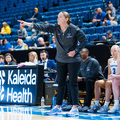No. 4 SU’s man-down unit concedes 4 goals in loss to No. 1 Cornell

Cornell converted 4-of-7 man-up opportunities to pace its 17-12 win over Syracuse. It's the most man-down goals SU has conceded in 2025. Jacob Halsema | Staff Photographer
Get the latest Syracuse news delivered right to your inbox. Subscribe to our sports newsletter here.
UNIONDALE, N.Y. — Man-down defense has been a strength for Syracuse this season. Through 11 games, it had the 20th-best man-down unit in the nation and hadn’t allowed more than two man-up goals in a game.
The Orange held Virginia — currently the ninth-best Division I man-up unit — to 2-of-4 on its extra-man chances in their 12-10 win on March 29. SU also contained then-No. 18 Colgate’s man-up crew, which sits 11th in the country, to a 2-for-8 clip in its 16-12 victory on March 22.
“It’s been great,” Syracuse head coach Gary Gait said of the man-down unit Thursday. “It’s only going to continue to get better as we head into the end of the year.”
For all the Orange’s man-down success, they hadn’t played Cornell’s high-octane offense. The No. 1 Big Red (10-1, 4-0 Ivy League) cashed in on 4-of-7 man-up opportunities, propelling their 17-12 win over No. 4 Syracuse (9-3, 2-0 Atlantic Coast) Saturday on Long Island. It’s the third time SU committed eight fouls this season and the most man-down goals it allowed since it also conceded four man-down goals in its collapse at then-No. 13 Cornell last season.
Despite Cornell placing 11th in the nation in man-up opportunities, converting at a .474 clip, it only had 19 extra-man chances entering Saturday’s contest — the second-lowest sample size among the top-15 man-up offenses.
When the Big Red did conduct their offense with a player advantage, it only heightened their already potent attacking unit.
“They’re a very good team,” Gait said of Cornell postgame Saturday. “They move the ball better than anybody in the country, and their man-up is very good.”
Last season, Syracuse’s man-down unit consisted of a brand-new unit off the bench. It finished as the third-best team in the stacked ACC with a 64.4% man-down success. Despite its success, this season, Gait said he and second-year defensive coordinator John Odierna tweaked their strategy to include starters and fresh legs off the bench.
It worked effectively for most of the year before it was struck by Cornell’s unit. With the Big Red ahead 4-2 with three minutes left, SU freshman attack Payton Anderson was called for holding. Once in the catbird seat, the ball didn’t stick with Cornell. It carved up the Orange like it was making a decorative fruit plate, and the final incision was a Rory Graham turnaround blast.
“They were shooting well today,” Gait said. “I thought they were on top of it shot-wise. And we weren’t getting stops. So they had a great day.”
When Billy Dwan III was assessed a pushing penalty, Cornell’s ball movement was dizzying. After swinging the ball around SU’s assembled man-down unit, a four-pass sequence allowed the Big Red to score their fifth unanswered goal. Hugh Kelleher cut outside to receive a pass on the left wing. The ball found Ryan Goldstein on the left goal-line extended. Goldstein didn’t hold the ball for long, touching it to a cutting Graham. Graham powered the shot home like a tennis volley.
“They moved the ball well. They played well together. They managed the space well, and at the end of the day, they scored,” Cornell head coach Connor Buczek said of his man-up unit postgame. “Those guys did an excellent job this week and are really getting better and making some improvements.”
After Syracuse went on a 3-0 run, Cornell broke the streak with a strike just two minutes after a Carter Rice holding penalty. It was a moment of CJ Kirst magic, as he wrapped around the net and slotted his shot past Jimmy McCool in net. It didn’t count as a man-up goal since Rice’s penalty had expired two seconds before Kirst’s went in.
Kirst then set up Andrew Dalton, who scored Cornell’s 10th goal to build a three-goal lead. Yet, on top of conceding, Syracuse’s Michael Leo was called for a minute cross-check penalty. Cornell made the most of its opportunity again. Goldstein again provided, setting up Willem Firth from the X. Firth rocketed his bid into the goal.
The same sequence played out four minutes later. With a flag on the turf, Kirst scored. Then, once Figueiras was assessed a 60-second penalty, the Big Red lined up in a 1-4-1 on offense, eventually finding Michael Long, who was the farthest left on the midfield four in front of the net. Long converted what would end up being the game winner to push the score to 13-7
It’s often said in sports that the ball moves faster than the player. Cornell proved that axiom against Syracuse. Its offense played at a breakneck pace while maintaining control — a high-wire act executed to perfection. Syracuse had enough trouble slowing down the Big Red when it was at full strength. When it went down a man, forget about it.
“We saw some things we liked on tape, and they executed at a high level,” Buczek said. “That group, the special teams, make all the difference in a big game.”
Saturday was a big game. It was No. 1 versus No. 4. It was a regional rivalry. It was hosted and promoted by a preeminent lacrosse company. That’s what a No. 1 team can do: turn a strength into a glaring weakness. And with its well-drilled ball movement and clinical finishing, the Big Red certainly did that to the Orange’s man-down defense.






